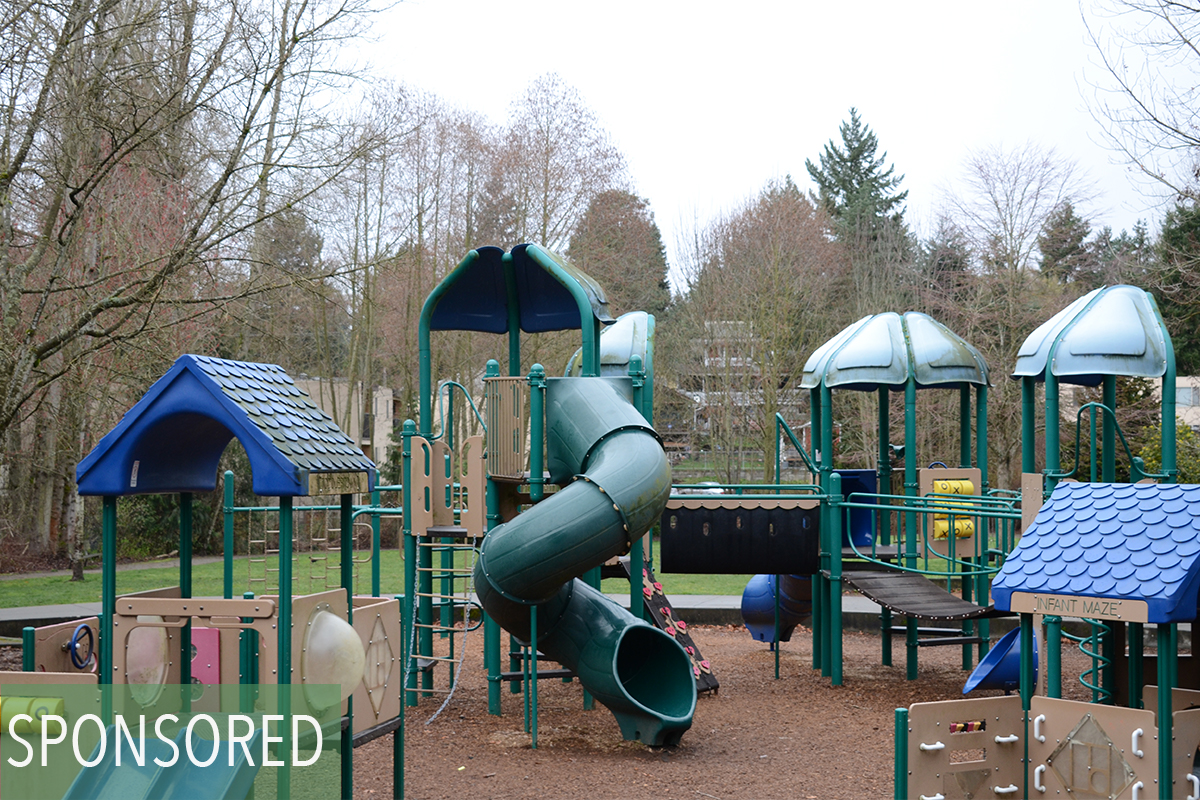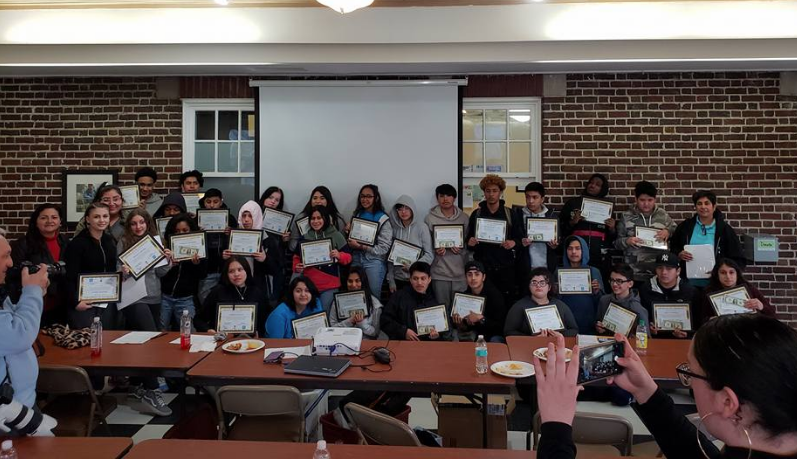

By Kamna Sashtri for Puget Sound Future-Makers
The sun came out just in time for Duwamish Valley Youth Corps graduation on a rainy Thursday afternoon on March 22. Youth poured into the South Park Community Center with their parents, grabbing plates full of snacks before settling down. The graduation celebration marked twelve weeks of hard work in the neighborhood planting trees, cleaning up graffiti, and exploring future careers and opportunities.

As Community Engagement and Outreach Manager, Paulina Lopez leads the four-year-old program under the Duwamish River Cleanup Coalition/Technical Advisory Group (DRCC/TAG). She urged everyone to get food before starting, switching fluidly between English and Spanish throughout the evening.
The Youth Corps program supports environmental and health improvement projects, including urban forestry, identified as priorities by residents. Forty-nine young people were a part of the most recent winter cohort, including twenty-four first-timers. The rest were mentors, many of whom have come back multiple years in a row.
“Think about the experience you’ve learned and take it to the future. Not everyone has a chance to make a difference, and you already have,” Lopez said at the graduation ceremony, making eye contact with the youth in the room.

When Lopez first came to the U.S, she didn’t expect to see a disparity in the quality of life for communities of color. Having worked on social justice issues in Ecuador, she thought she could learn strategies to employ upon her return home.
“You think [the] U.S is a very good example for many things but when I came here, I said, ‘What do you mean there’s a difference from one community to another?’ so that kind of got me very involved in the work I do,” said Lopez.
South Park, Lopez said, has the highest rate of youth per capita in the area, a large percentage of whom are young people of color. Despite that demographic, the area hardly has any youth programs and has had issues with gang violence. Duwamish Valley Youth Corps began after the community prioritized a need for positive youth engagement opportunities.

Lopez said neighbors have had a positive reaction to the Youth Corps. Seeing young people in action and creating change in their own neighborhood counters the image of gang life, she explained. Where youth weren’t necessarily seen as a positive force in the community before, now their efforts to clean the neighborhood have been appreciated.
Each cohort in the program decides what issues to tackle and how to tackle them. One of the winter cohort’s top challenges has been air pollution. To mitigate the impacts of pollution, youth chose to plant trees. They’ve planted over two-thousand so far.
“[With] every cohort, it changes because we make sure they are choosing,” said Lopez.
Part of the Youth Corps curriculum is to introduce youth to concepts of environmental justice, educating them on the history of the Duwamish river, from being the home of the Duwamish tribe, to its heavy industrial use by Boeing during WWII (leading to its current status as a Superfund site). Some youth are even pursuing environmental careers, such as environmental law, Lopez said.
Along with cultivating environmental education and community stewardship, the Youth Corps members are learning life skills while forming camaraderie.
Alexa C. Garcia has been part of Youth Corps for three years, two of them as a mentor.
“Youth Corps has taught me a sense of responsibility in the things that I do even more than I already have. And how to work hard,” Garcia said.
Almost all the young people in the cohort are youth of color, and Lopez said many of them return home from school to empty homes, or a trying family environment. Youth Corps is not only a place to better the community and learn about future career opportunities, but it is place where youth feel guided and embraced, Lopez said.
As each youth from the graduating cohort stepped forward to receive their certificate, Lopez warmly highlighted a unique quality about each person. She compliments one girl’s smile. And to another young man, she says “never change who you are.”

Meanwhile, up north in Lake City, Mark Mendez is program manager for Little Brook Youth Corps. He’s a Lake City native and is bringing in youth participation to revitalize the neighborhood. Started last year, the LBYC has used Duwamish Valley Youth Corps’ model to get Lake City Youth involved. Mendez created the corps through a new partnership with Seattle Parks Foundation, which serves as a fiscal sponsor for LBYC, Duwamish Valley Youth Corps, and roughly 60 other community groups across Seattle—ensuring they have the administrative, financial, fundraising, communications, and advocacy support they need.
Thousands of cars and busses whoosh down Lake City Way every morning and evening during rush hour. But Lake City isn’t just a thoroughfare, it is a dense, vibrant community full of small-town charm, looking to revitalize, support its refugee and immigrant population, and to conserve and clean up the few greenspaces and natural waterways that still run through the locale.
One of these green spaces—the only public one in fact—is Little Brook Park on 32nd Avenue, just parallel to Lake City Way. It’s got a brightly colored playground with a curving patch of green grass directly behind. The park, and the neighboring complex, is named after the brook that winds through the back of the park.
Last summer, Mendez guided Lake City middle schoolers through the program for the first time. It’s because of them that the gurgling water is no longer just a sound, but a creek that children and nature lovers can admire. Before the summer, invasive species towered chest high, hiding the brook from view. Trash littered the ground. The youth removed the invasive species, cleaned up trash and planted native species, such as ferns, that peek out from the ground.
While the creek is accessible at Little Brook Park, the rest of it meanders beneath ground, winding under Lake City’s businesses and streets, daylighting only here and there. One place where the creek emerges is on private property. Mendez calls it an oasis of sorts. Once, there, the street noise fades away, replaced by chirping birds, rushing water and the scent of earth. Mendez says that one day he hopes that all the parts of the creek that are above ground can be connected, with bike and pedestrian paths so that Lake City residents can enjoy natural habitat.
Lake City is densely populated. As expensive apartments rise along Lake City Way, they stand alongside low income and affordable housing complexes, housing families including those with refugee and immigrant status. Too often, these families—and their youth—are left out of decision-making processes that affect where they live. Mendez noted community meetings bring in richer, whiter folks who have the time to get engaged.
“If we can’t get people of color to come to those meetings, decisions won’t be made that can benefit those underserved populations,” said Mendez.
This concern has propelled Mendez to work with youth, imparting the knowledge he has gained from organizing the neighborhood over the past five years.
“They are learning from non-profit leaders who are using tools to improve the neighborhood, so they can actually start thinking about this now and not years later. Then they are adults, it’s almost too late to get people involved,” he said.
Kevin Munoz will be a mentor for the upcoming summer cohort of the Little Brook Youth Corps. The park was one his favorite spots to play as a child.
“When I saw the opportunity to be a part of something that would help other kids, I took the opportunity … Little Brook gave me an opportunity to fix them and give other kids a better place,” he said.
Munoz said that unlike adults, young people know what would best benefit them. They also understand why changes are needed. He points to Lake City’s lack of sidewalks and bike lanes, something he hopes will be in abundance in the future.
Mendez said that changes for the neighborhood are not going to come quickly. It’s going to be a intensive process.
“it’s going to be a five, 10, 20-year plan where you empower these teens to take ownership and be leaders in their neighborhood,” Mendez said.
It’ll take time, but mentors like Mendez and Lopez are raising a generation of new leaders who are investing in their futures with each weed they remove and every tree they plant.
This story is part of the series “Puget Sound Future-Makers,” a partnership with the Russell Family Foundation, Resource Media and The Seattle Globalist, which recognizes the work of diverse leaders in the Puget Sound region in shaping the strength and resilience of our future environment and communities.

